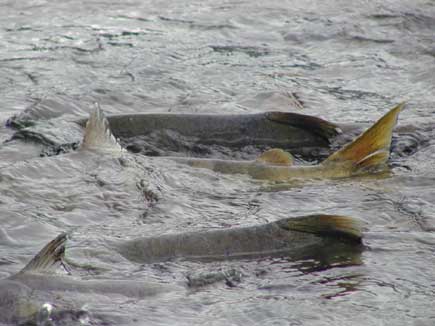What makes diadromous fish different than other fish types is the way that they spawn. Anadromous fish travel from the ocean (learn about the Salts in Seawater), where they reach sexual maturity, to rivers and streams where they can lay their eggs. Catadromous fish, on the other hand, travel from fresh water to the ocean to lay eggs. 
Salmon spawning in Juneau, Alaska (July)
Anadromous fish for the most part make this journey only once in their lifetime. A perfect example of this fish type is the Pacific Salmon. After they spend several years in the ocean, they migrate up the same river that they were born in. How they find the exact river is still a mystery; but it has been speculated that they use their sence of smell. The ideal nesting location, or Redd, for salmon is a rocky bed without large amounts of silt deposits. It should be in a relatively shallow area, but protected from predators and should also stay under water all year. With an abundance of food and shelter, this is a good place for the offspring to hatch and grow. The young fish spend usually around two years in the river that they were born in until they move downstream to the ocean.
A Catadromous fishs' life cycle is almost the opposite of an Anadromous fish. They hatch in the ocean, and spend the majority of their lifetime in freshwater rivers, lakes and estuaries. Learn more about estuaries from the ROCK rivers and estuaries site.They then migrate back to the ocean to spawn. An example of this category the American Eel. After hatching in salt water at about two inches long, they then move with the current for about nine to twelve months till they reach the coastlines. Some young eels stay in estuaries near the ocean, but some migrate up rivers and into lakes, traveling sometimes hundreds of kilometers. They often overcome difficult obstacles like rapids, spillways and dams before spending a couple of years in fresh water. |




